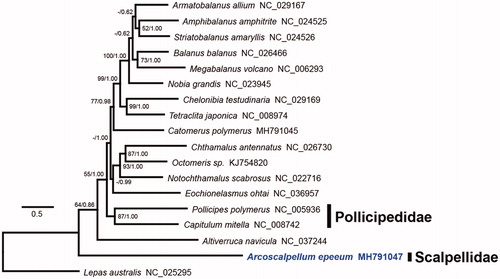Abstract
Scalpellids are one of the largest families of Scalpelliformes and reproduce either androdioeciously or dioeciously. Here, we characterized the first mitogenome of a scalpellid barnacle (Arcoscalpellum epeeum), which was 15,593 bp in length with a 71.5% AT content. In comparison with the pollicipedids Capitulum mitella and Pollicipes polymerus, the tRNA genes of A. epeeum were rearranged between ND3 and ND5, between CYTB and ND1, and between 12S rRNA and ND2. On the mitogenomic tree, the Scalpelliformes families Pollicipedidae and Scalpellidae were not monophyletic, which concurs with previous studies.
Stalked barnacles of the order Scalpelliformes are found in various marine aquatic environments ranging from the intertidal zone to the deep sea and show great reproductive diversity, including hermaphroditism, androdioecy, and dioecy (Lin et al. Citation2015). Despite revising Scalpelliformes to consist of five families, Calanticidae, Eolepadidae, Lithotryidae, Pollicipedidae, and Scalpellidae, it was still found to be polyphyletic (Buckeridge and Newman Citation2006; Ahyong et al. Citation2011; Herrera et al. Citation2015; Lin et al. Citation2015). As of 24 August 2018, GenBank contains two complete mitochondrial genomes (mitogenomes) from hermaphrodite pollicipedid barnacles, but no mitogenomes from the other families. Scalpellids are one of the largest families of Scalpelliformes, with over 260 species and have either androdioecious or dioecious reproductive systems (Chan et al. Citation2014). To understand the phylogenetic relationships and reproductive evolution of Scalpelliformes, we determined the first mitogenome of a deep-sea scalpellid barnacle, Arcoscalpellum epeeum, which is androdioecious.
Arcoscalpellum epeeum specimens were collected from the Norfolk Ridge between New Caledonia and New Zealand (22°53′S and 167°12′E; 403–429 m depths). The genomic DNA extraction, sequencing, gene annotation, and phylogenetic analyses followed Kim et al. (Citation2017, Citation2018). The specimen used for the mitogenomic analysis has been deposited in the Biodiversity Research Museum, Academia Sinica, Taiwan (ASIZCR).
The complete mitogenome of A. epeeum is 15,593 bp in length (71.5% AT content; GenBank accession no. MH791047), consisting of 13 protein-coding genes (PCGs), two ribosomal RNAs (rRNAs), 22 transfer RNAs (tRNAs), and one non-coding region. The intergenic region between tRNATrp and ND2 was not determined completely, despite our efforts using Sanger sequencing and comparative mitogenomics.
The gene arrangement and transcriptional polarity showed the ancestral pancrustacean pattern, except for some tRNAs. In comparison with the Scalpelliformes Capitulum mitella and Pollicipes polymerus, the tRNA genes in the A. epeeum mitogenome were rearranged between ND3 and ND5, between CYTB and ND1, and between 12S rRNA and ND2. All of the PCGs had an ATN start codon, except COX1, for which the start codon was not determined. Most of the PCGs terminated with a complete stop codon (TAA or TAG), although COX1, COX3, and ND4 had incomplete stop codons (T–). The 16S and 12S rRNAs were 1299 bp (76.3% AT content) and 753 bp (70.8% AT content), respectively. A 118-bp-long (76.3% AT content) non-coding region was located between the 12S rRNA and tRNAIle.
A phylogenetic tree was constructed using the PCGs of 18 barnacles using maximum likelihood and Bayesian inference (). The scalpellid barnacle A. epeeum was positioned as an ancestral node of verrucomorph and balanomorph barnacles. Two Scalpelliformes families, Pollicipedidae and Scalpellidae, were not monophyletic, which concurs with previous studies (Pérez-Losada et al. Citation2008; Linse et al. Citation2013; Herrera et al. Citation2015; Lin et al. Citation2015). In Scalpelliformes, the mitogenomes of Calanticidae, Eolepadidae, and Lithotryidae have not been determined, and further mitogenomic analysis of undetermined taxa is required to deepen our understanding of their phylogeny, sexual evolution, and biogeography.
Figure 1. Phylogenetic tree of Arcoscalpellum epeeum and other thoracican barnacles based on 13 protein-coding genes from mitogenomes. The model GTR + I + G was selected as the best evolutionary model using jModelTest 2.1.4 (MEGA Inc., Ocheyedan, IA). Numbers at internodes are the maximum-likelihood bootstrap proportions (left) and Bayesian posterior probabilities (right). An asterisk indicates a bootstrap value of less than 50%.

Disclosure statement
The authors report no conflicts of interest. The authors alone are responsible for the content and writing of the paper.
Additional information
Funding
References
- Ahyong ST, Lowry JK, Alonso M, Bamber RN, Boxshall GA, Castro P, Gerken S, Karaman GS, Goy JW, Jones DS, et al. 2011. Order Scorpiones C.L. Koch, 1850. In: Zhang, Z.-Q, editor. Animal biodiversity: an outline of higher-level classification and survey of taxonomic richness. Zootaxa. 3148:165–191.
- Buckeridge JS, Newman WA. 2006. A revision of the Iblidae and the stalked barnacles (Crustacea: Cirripedia: Thoracica), including new ordinal, familial and generic taxa, and two new species from New Zealand and Tasmanian waters. Zootaxa. 1136:1–38.
- Chan BKK, Corbari L, Rodriguez Moreno PA, Jones DS. 2014. Two new deep-sea stalked barnacles, Arcoscalpellum epeeum sp. nov. and Gymnoscalpellum indopacificum sp. nov. from the Coral Sea, with descriptions of the penis in Gymnoscalpellum dwarf males. Zootaxa. 3866:261–276.
- Herrera S, Watanabe H, Shank TM. 2015. Evolutionary and biogeographical patterns of barnacles from deep-sea hydrothermal vents . Mol Ecol. 24:673–689.
- Kim S-J, Lee W-K, Hou BK, Chan BKK, Ju SJ. 2017. Complete mitochondrial genome of the deep-sea asymmetrical barnacle Altiverruca navicula (Cirripedia, Thoracica, Verrucumorpha). Mitochondrial DNA B Resour. 2:934–935.
- Kim S-J, Lee W-K, Kim RO, Ju SJ. 2018. Complete mitochondrial genome of the hydrothermal vent barnacle Eochionelasmus ohtai (Cirripedia, Thoracica). Mitochondrial DNA B Resour. 3:46–47.
- Lin HC, Hoeg JT, Yusa Y, Chan BKK. 2015. The origins and evolution of dwarf males and habitat use in thoracican barnacles. Mol Phylogenet Evol. 91:1–11.
- Linse K, Jackson JA, Fitzcharles E, Sands CJ, Buckeridge JS. 2013. Phylogenetic position of Antarctic Scalpelliformes (Crustacea: Cirripedia: Thoracica). Deep Sea Res Part 1 Oceanogr Res Pap. 73:99–116.
- Pérez-Losada M, Harp M, Høeg JT, Achituv Y, Jones D, Watanabe H, Crandall KA. 2008. The tempo and mode of barnacle evolution. Mol Phylogenet Evol. 46:328–346.
